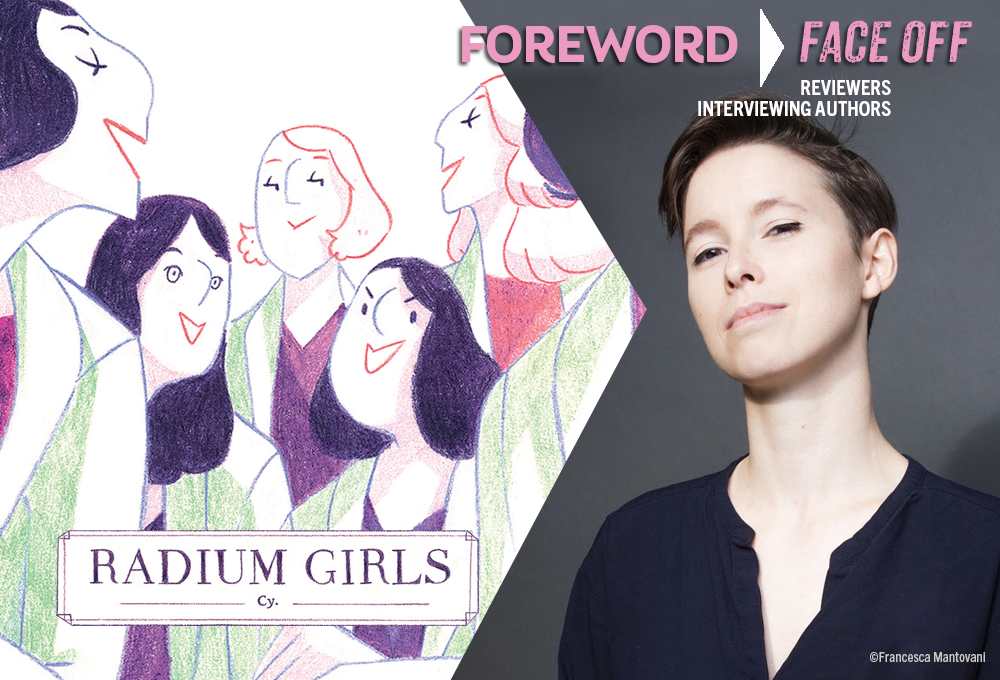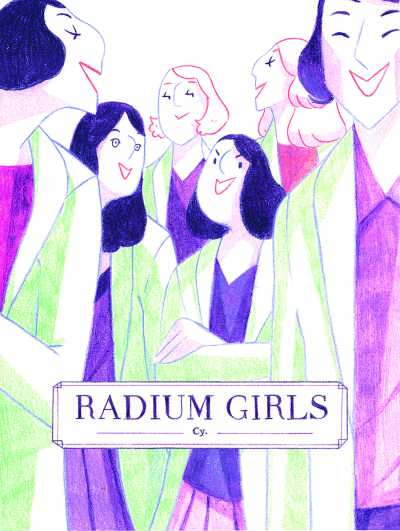Reviewer Peter Dabbene Interviews Cy, Author of Radium Girls

When the history of history gets written—by a woman, preferably—we’ll gain a much better understanding of how and why recorded events have been purposely misrepresented, even falsified, in countless examples. The power of human memory has always rested in whoever held the pen: namely, almost exclusively, white men.
Keep that thought in mind when you read today’s interview and learn about another horrifying case of the male whitewashing—do us a favor and invent a witty word that encapsulates white-male-whitewashing—of an injustice committed against a marginalized group.

This is the story of Radium Girls, a new graphic novel reviewed by Peter Dabbene in Foreword’s May/June issue. Peter caught up with graphic novelist Cy and learns how she came upon this story and her working methods.
Enjoy the interview!
Reading Radium Girls shocked me in several ways—the tragic, widespread ignorance of the negative consequences of radioactivity in 1918; the lack of workplace safety standards at the time; and the limited occupational options for working women. How did you first learn about this disturbing bit of history, and did you have a similar initial reaction?
I discovered this story while scrolling absent-mindedly through Twitter. The term “Radium Girls” hooked me; I thought it was a girl band from the ‘50s! I knew pretty much nothing about this topic before reading a few articles. The story of these women is incredibly layered; if I had wanted to invent it, I would have certainly been told the story was “too much.” The Radium Girls were literally sacrificed on the altar of “modernity,” but worse than the radium itself is the society of this time period that crushed them. My first reaction was anger and it’s still the emotion that drives me today.
What approach did you take in researching the story of the Radium Girls?
I am not a historian; I therefore had to brush up on the political context of this time period, on the use of radium, on society at the time, fashion, working conditions, etc. I compiled a lot of documentation: news articles, scientific articles, books on the topic to have a solid base. Using this base, I then wove a plot together. My graphic novel isn’t a biography; it is a work inspired by true events. For the sake of the narration, I sometimes had to twist reality on certain points while being careful not to transfigure the entire work. It’s a balancing act!
The limited palette/colored pencil art style showcased in Radium Girls is striking, especially as it’s used in the book to draw attention to certain plot elements, whether radioactivity or an emotional conflict. Is this your preferred method of graphic illustration, or does it vary based on the project?
I really like to work with restricted color tones. This allows me to develop the ambiance and give a certain tint to the work. While I was looking for the color harmony, it was obvious that the shades of purple/pink/blue perfectly highlighted the radium green. Like an ominous red thread, we find it everywhere in the graphic novel, omnipresent like it is in the life of the Radium Girls.
That said, this color method doesn’t apply to all of my work. For this story, it made sense. The color is a tool that serves the story. If the narration changes, my artistic method changes, too!
You use the pen name Cy, which is a shortened version of your full name, Cyrielle Evrard. What led you to use a nom de plume?
I haven’t changed my pseudonym since I was 14 and making rather embarrassing fanart inspired by the Naruto universe. What lead me to going by Cy is adolescence and the desire to be cool, haha! In the end, I never thought to change it.
You studied at the École de Condé Paris, a fact that’s evident from the technical skill and compositional eye demonstrated in this book. But how much of your graphic storytelling knowledge came from your studies there, as opposed to absorbing the influences of other European comic book artists? Are there any artists, in any genre, that stand out as particularly influential or inspirational for you?
It’s true that I studied art, but never comics. In this field, I am self-taught like many of my peers. My studies were mainly in graphic design, then in illustration, and that certainly sharpened my eye for framing. As for the storytelling, I started drawing little stories on my blog during the golden age of blogBDs in France in the 2000s. They weren’t great, but it was good practice!
I also read tons of virtuoso authors on the subject: Aude Picault, Cyril Pedrosa, Pénélope Bagieu, Jillian and Mariko Tamaki, Manuel For, Isabelle Arsenault … there are so many!
Your previous books are not available in English. What was your experience having your work translated from French for the first time? With Radium Girls marking your entry into the United States and the English-speaking market, do you see yourself targeting future projects for a worldwide audience?
Translations are always a pleasure: seeing one’s work exported to other countries and, for my part, to make the forgotten story of the Radium Girls even more known. The English translation and the story’s export to the US is even more important; their history is the one in question. Of course, books on the subject are already available in English, but let’s just say that my graphic novel is another stone in the monument of these women. We don’t have the right to forget them again.
Radium Girls seems like the Holy Grail of stories for a graphic novelist: a little-known but deeply affecting story, with characters and situations that are specific to a particular place and time, yet prove universally relevant and inspiring. And your art style seems to fit the subject perfectly. So what’s next for you?
The next step is miles away from Radium Girls! I’m in the midst of launching, with my author Marc Dubuisson, a series for the general public on pirates in a fantasy world: “Ana et l’Entremonde.” We follow Ana and Domingo, two young orphans, who find themselves embarked on the famous expedition of Christopher Columbus, heading to the Indies. Unfortunately for them, in this version of history, the world is flat. Once they arrive at the falls at the end of the world, they find themselves thrown into a fantastic universe populated by creatures and pirates of all kinds: the Entremonde (Middleworld).
I know I was expected to write a new historical story, but I have to admit that I don’t like to redo what I’ve already done. I wanted to do something completely different, to do a long story (four volumes), with a new medium (in direct ink colors), on lands I’ve never explored! The first volume will be released in France on September 21st, 2022 by Glénat!
Peter Dabbene
